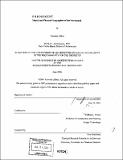| dc.contributor.advisor | William L. Porter. | en_US |
| dc.contributor.author | Abbas, Yasmine | en_US |
| dc.contributor.other | Massachusetts Institute of Technology. Dept. of Architecture. | en_US |
| dc.date.accessioned | 2011-05-23T17:51:50Z | |
| dc.date.available | 2011-05-23T17:51:50Z | |
| dc.date.copyright | 2001 | en_US |
| dc.date.issued | 2001 | en_US |
| dc.identifier.uri | http://hdl.handle.net/1721.1/62952 | |
| dc.description | Thesis (S.M.)--Massachusetts Institute of Technology, Dept. of Architecture, 2001. | en_US |
| dc.description | Includes bibliographical references (leaves 57-58). | en_US |
| dc.description.abstract | Globalization is today significantly debated. The ineluctable phenomenon has led to homogenization, hybridization, cultural confusion, and social disorders. The resulting chaos has been translated by a loss of landmarks, which has consequently engendered mental and physical displacements. New species, hybrids, have emerged from these various cultural encounters. Displaced, these populations of the border, the 'third' space, have developed their adaptation skills, including choice and negotiation, in order to assert a sense of belonging. Among the plethora of today's nomads such as refugees, global workers, and immigrants for example, hybrids are species that have mutated. They have become something detached from established orders, and not attached to any specific place. Like nomads, they move and adapt. Neo-nomads, then, in their effort to adapt and build a sense of belonging not bound to place, reminds us of the traditional nomads. By analyzing the hybrid, the ensuing spatiality, skins, and geographies of the neo-nomad, this thesis offers an open-ended discussion about mobility, connectivity and space. These observations lead to the conclusion that nomads we were, nomads we are, and nomads we will be, always. | en_US |
| dc.description.statementofresponsibility | by Yasmine Abbas. | en_US |
| dc.format.extent | 58 leaves | en_US |
| dc.language.iso | eng | en_US |
| dc.publisher | Massachusetts Institute of Technology | en_US |
| dc.rights | M.I.T. theses are protected by
copyright. They may be viewed from this source for any purpose, but
reproduction or distribution in any format is prohibited without written
permission. See provided URL for inquiries about permission. | en_US |
| dc.rights.uri | http://dspace.mit.edu/handle/1721.1/7582 | en_US |
| dc.subject | Architecture. | en_US |
| dc.title | E M B O D I M E N T : mental and physical geographies of the neo-nomad | en_US |
| dc.title.alternative | Embodiment : mental and physical geographies of the neo-nomad | en_US |
| dc.title.alternative | Mental and physical geographies of the neo-nomad | en_US |
| dc.type | Thesis | en_US |
| dc.description.degree | S.M. | en_US |
| dc.contributor.department | Massachusetts Institute of Technology. Department of Architecture | |
| dc.identifier.oclc | 49554927 | en_US |
